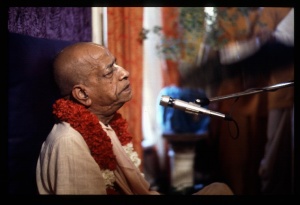CC Madhya 18.37 (1975): Difference between revisions
(Vanibot #0027: CCMirror - Mirror CC's 1996 edition to form a basis for 1975) |
(Vanibot #0020: VersionCompareLinker - added a link to the Version Compare feature) |
||
| Line 2: | Line 2: | ||
<div style="float:left">'''[[Sri Caitanya-caritamrta (1975)|Śrī Caitanya-caritāmṛta (1975)]] - [[CC Madhya (1975)|Madhya-līlā]] - [[CC Madhya 18 (1975)|Chapter 18: Lord Śrī Caitanya Mahāprabhu's Visit to Śrī Vṛndāvana]]'''</div> | <div style="float:left">'''[[Sri Caitanya-caritamrta (1975)|Śrī Caitanya-caritāmṛta (1975)]] - [[CC Madhya (1975)|Madhya-līlā]] - [[CC Madhya 18 (1975)|Chapter 18: Lord Śrī Caitanya Mahāprabhu's Visit to Śrī Vṛndāvana]]'''</div> | ||
<div style="float:right">[[File:Go-previous.png|link=CC Madhya 18.36 (1975)|Madhya-līlā 18.36]] '''[[CC Madhya 18.36 (1975)|Madhya-līlā 18.36]] - [[CC Madhya 18.38 (1975)|Madhya-līlā 18.38]]''' [[File:Go-next.png|link=CC Madhya 18.38 (1975)|Madhya-līlā 18.38]]</div> | <div style="float:right">[[File:Go-previous.png|link=CC Madhya 18.36 (1975)|Madhya-līlā 18.36]] '''[[CC Madhya 18.36 (1975)|Madhya-līlā 18.36]] - [[CC Madhya 18.38 (1975)|Madhya-līlā 18.38]]''' [[File:Go-next.png|link=CC Madhya 18.38 (1975)|Madhya-līlā 18.38]]</div> | ||
{{CompareVersions|CC|Madhya 18.37|CC 1975|CC 1996}} | |||
{{RandomImage}} | {{RandomImage}} | ||
==== TEXT 37 ==== | ==== TEXT 37 ==== | ||
<div class="verse"> | <div class="verse"> | ||
:gopālera saundarya | :gopālera saundarya dekhi' prabhura āveśa | ||
:ei śloka | :ei śloka paḍi' nāce, haila dina-śeṣa | ||
</div> | </div> | ||
| Line 18: | Line 17: | ||
<div class="synonyms"> | <div class="synonyms"> | ||
gopālera—of Gopāla; saundarya—beauty; | gopālera—of Gopāla; saundarya—beauty; dekhi'-seeing; prabhura—of Śrī Caitanya Mahāprabhu; āveśa—ecstasy; ei śloka paḍi'-reciting the following verse; nāce—dances; haila—there was; dina-śeṣa—the end of the day. | ||
</div> | </div> | ||
| Line 37: | Line 36: | ||
:ethā indra kaila govindera abhiṣeka | :ethā indra kaila govindera abhiṣeka | ||
"Govinda-kuṇḍa is exalted for its many spiritual activities. It was here that Indra was defeated by Lord Kṛṣṇa, and Indra offered his prayers and bathed Lord Govinda." In the book Stavāvalī (Vraja-vilāsa-stava 74) the following verse is found: | |||
:nīcaiḥ prauḍha-bhayāt svayaṁ | :nīcaiḥ prauḍha-bhayāt svayaṁ surapatiḥ pādau vidhṛtyeha yaiḥ | ||
:svar-gaṅgā-salilaiś cakāra surabhi-dvārābhiṣekotsavam | :svar-gaṅgā-salilaiś cakāra surabhi-dvārābhiṣekotsavam | ||
:govindasya navaṁ gavām adhipatā rājye sphuṭaṁ kautukāt | :govindasya navaṁ gavām adhipatā rājye sphuṭaṁ kautukāt | ||
:tair yat prādurabhūt sadā sphuratu tad govinda-kuṇḍaṁ dṛśoḥ | :tair yat prādurabhūt sadā sphuratu tad govinda-kuṇḍaṁ dṛśoḥ | ||
In the Mathurā-khaṇḍa it is also stated: | |||
:yatrābhiṣikto bhagavān | |||
:maghonā yadu-vairiṇā | |||
:govinda-kuṇḍaṁ taj-jātaṁ | |||
:snāna-mātreṇa mokṣadam | |||
"Simply by bathing in Govinda-kuṇḍa, one is awarded liberation. This lake was produced when Bhagavān Śrī Kṛṣṇa was bathed by Lord Indra." | |||
Gāṅṭhuli-grāma is situated near the two villages Bilachu and Gopāla-pura. According to hearsay, Rādhā and Kṛṣṇa first met here. In the Bhakti-ratnākara (Fifth Wave), it is stated: sakhī duṅha vastre gāṅṭhi dila saṅgopane. It is also stated: phāguyā laiyā keha gāṅṭhi khuli' dilā. For this reason the village is known as Gāṅṭhuli. | |||
Gāṅṭhuli-grāma is situated near the two villages Bilachu and Gopāla-pura. According to hearsay, Rādhā and Kṛṣṇa first met here. In the Bhakti-ratnākara (Fifth Wave), it is stated | |||
</div> | </div> | ||
Latest revision as of 11:25, 27 January 2020

A.C. Bhaktivedanta Swami Prabhupada
TEXT 37
- gopālera saundarya dekhi' prabhura āveśa
- ei śloka paḍi' nāce, haila dina-śeṣa
SYNONYMS
gopālera—of Gopāla; saundarya—beauty; dekhi'-seeing; prabhura—of Śrī Caitanya Mahāprabhu; āveśa—ecstasy; ei śloka paḍi'-reciting the following verse; nāce—dances; haila—there was; dina-śeṣa—the end of the day.
TRANSLATION
As soon as the Lord saw the beauty of the Gopāla Deity, He was immediately overwhelmed by ecstatic love, and He recited the following verse. He then chanted and danced until the day ended.
PURPORT
Śrīla Bhaktisiddhānta Sarasvatī Ṭhākura gives the following information about Govinda-kuṇḍa. There is a village named Āniyora on Govardhana Hill, a little distance from the village of Paiṭhā. Govinda-kuṇḍa is situated near here, and there are two temples to Govinda and Baladeva there. According to some, Queen Padmāvatī excavated this lake. In the Bhakti-ratnākara (Fifth Wave), the following statement is found:
- ei śrī-govinda-kuṇḍa-mahimā aneka
- ethā indra kaila govindera abhiṣeka
"Govinda-kuṇḍa is exalted for its many spiritual activities. It was here that Indra was defeated by Lord Kṛṣṇa, and Indra offered his prayers and bathed Lord Govinda." In the book Stavāvalī (Vraja-vilāsa-stava 74) the following verse is found:
- nīcaiḥ prauḍha-bhayāt svayaṁ surapatiḥ pādau vidhṛtyeha yaiḥ
- svar-gaṅgā-salilaiś cakāra surabhi-dvārābhiṣekotsavam
- govindasya navaṁ gavām adhipatā rājye sphuṭaṁ kautukāt
- tair yat prādurabhūt sadā sphuratu tad govinda-kuṇḍaṁ dṛśoḥ
In the Mathurā-khaṇḍa it is also stated:
- yatrābhiṣikto bhagavān
- maghonā yadu-vairiṇā
- govinda-kuṇḍaṁ taj-jātaṁ
- snāna-mātreṇa mokṣadam
"Simply by bathing in Govinda-kuṇḍa, one is awarded liberation. This lake was produced when Bhagavān Śrī Kṛṣṇa was bathed by Lord Indra."
Gāṅṭhuli-grāma is situated near the two villages Bilachu and Gopāla-pura. According to hearsay, Rādhā and Kṛṣṇa first met here. In the Bhakti-ratnākara (Fifth Wave), it is stated: sakhī duṅha vastre gāṅṭhi dila saṅgopane. It is also stated: phāguyā laiyā keha gāṅṭhi khuli' dilā. For this reason the village is known as Gāṅṭhuli.